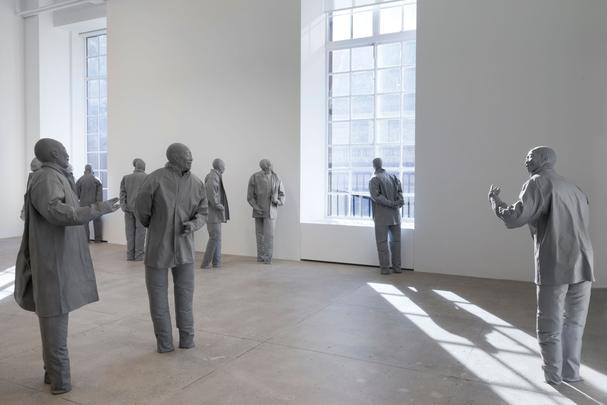
The late Spanish sculptor Juan Muñoz (1953-2001) loved card tricks. He did a whole series of radio programs, in fact, where he explained different tricks. In turn, he once described the principle of his work as “sleight of hand.” Trickery is probably not the first thing that comes to mind when you see the work in the small survey at Marian Goodman’s uptown space, though: Muñoz’s sculptures and works on paper have a kind of restraint and seriousness throughout. They are odd but elegant.
What I want to do here is explain how I think Muñoz’s particular magic trick works, passing through one particular work in the show.
Juan Muñoz, Many Times (1999).
Photo: Ben Davis
Many Times (1999) is one of Muñoz’s most celebrated creations: A gallery crowded with figures, all cast in matte gray resin, all basically identical—a laughing Asian man, eyes pressed closed, head bald (the image is derived from a Belgian portrait bust). Each figure wears an identical jumpsuit, but is frozen in a different, slightly stiff posture.
Muñoz ran away from the drabness of Franco’s Spain at 17, trained to be an artist in London, and spent time in Stockholm and New York before moving back to Madrid, where he developed his career. As you might expect from someone with this background, he was an adventurous misfit: In the 1980s, he was into figurative sculpture when it was still considered recherché. At the same time, from his studies, he definitely had absorbed the expanded possibilities of contemporary installation (his final work was an ambitious environment for the Tate’s immense Turbine Hall, finished days before his death at 48).
Juan Muñoz, Many Times (1999).
Courtesy Marian Goodman
Many Times shows off Muñoz’s deadpan theatrical flair, his ability to draw you in: You immediately want to walk among the clusters of laughing figures, deciphering their relationships with one another. They seem to bunch together in silent, slightly creepy amusement, some congregating for a meeting, some greeting each other across the room, some looking as if they have just bumped into each other on the street and are chortling at the coincidence.
Some relate to the architecture too: a pair gesture out the tall gallery window, as if talking about the view. (Muñoz often made work that specifically activated the gallery space; elsewhere at Goodman, he has sculptures that take the form of balconies, implying that the whole expanse of the wall should read as the exterior of a building.)
Juan Munoz, Many Times (1999).
Courtesy Marian Goodman
The configuration of Many Times is so lively that it is only after a second walk-through that you start to think about some of the sculptures’ other traits. First: All the sculptures are about a quarter smaller than life-size. So even though they seem very much to be sharing the same space as you, you also seem to be looking at them from afar.
Detail of Juan Muñoz, Many Times (1999).
Photo: Ben Davis
Second: They are uniformly cut off at the ankles. Thus, though they are interacting with the space you are in, they also don’t appear to be quite synched up with it, like an errant hologram.
Detail of Juan Muñoz, Many Times (1999).
Photo: Ben Davis
Finally: the hands. In figure after figure, the hand is an awkward wreck, as if it were cast from a rubber glove that had been mashed up. Since it is the figures’ gestures that render them as individuals communicating with each other, this detail is like a clue about the hollowness of the whole thing.
For me, after you notice the hands, you re-see Many Times. You thought that it was a group of figures conversing—but this is an illusion. There is no meaning between them. Turn one slightly, and it would be part of another conversation; or completely disconnected.
Juan Muñoz, Many Times (1999).
Photo: Ben Davis
You thought that they were relating to the space, but it turns out this is just an effect of placement. They could be anywhere, contemplating anything.
You thought Many Times was an installation. It is just a collection of isolated figures, repeated “many times.”
Juan Muñoz, Many Times (1999).
Courtesy Marian Goodman Gallery
To say an artwork is “magical” is a cliché of an industry that peddles both reverence and novelty. To think of art-making instead as sleight of hand means something else: Many Times is like one of the card tricks Muñoz relished, even as he explained how the illusion was done. In a weird, inverted way, it’s because it is somehow about its own arbitrariness that it ends up being meaningful to look at.
Juan Muñoz is on view at Marian Goodman, 24 West 57th Street, New York, through January 29, 2015.